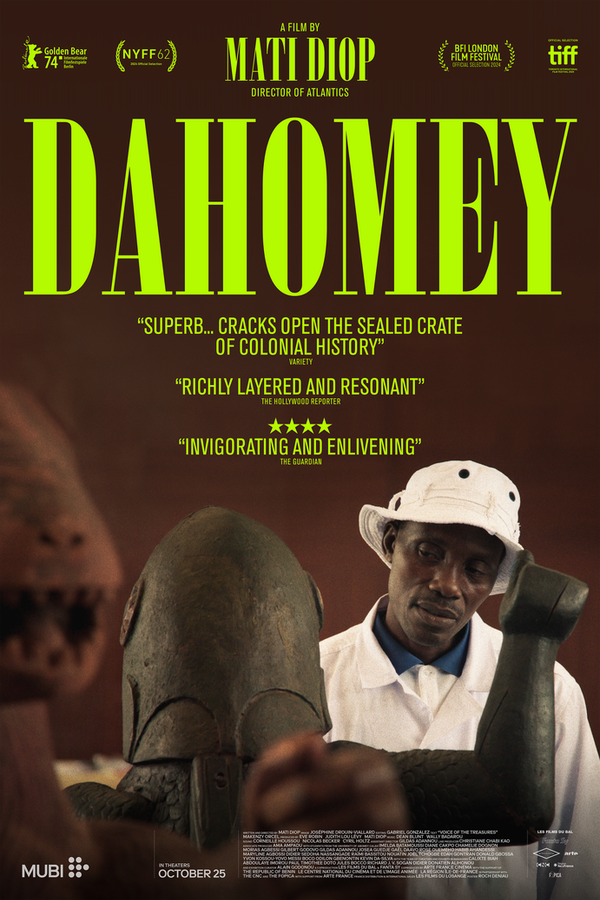What's After the Blog?
Opinions • reception
Dahomey (2024) Review: Critics' Opinions and Audience Reactions on Cultural Heritage and Identity
Explore the reception of Dahomey, a thought-provoking documentary about cultural heritage and restitution. Dive into critic reviews and fan reactions on its storytelling, performance, and the historical context of the artifacts' return.
June 12, 2025

Movies mentioned in this article
Exploring User and Critic Reviews for “Dahomey” (2024)
The 2024 documentary film Dahomey, directed by Mati Diop, has sparked a varied spectrum of reactions among both critics and audiences. This insightful documentary about the themes of cultural restitution and colonial history runs just over an hour and has been described as educational, intimate, and even a “minor treasure” by reviewers. In this blog, we will delve into the different opinions surrounding Dahomey, analyzing its reception, and highlighting key themes and sentiments from various perspectives.
Public and Critical Sentiment Towards “Dahomey”
The overall sentiment surrounding Dahomey tends to be overwhelmingly positive. Critics such as The Globe and Mail have commended the film for its poetic exploration of the contradictions and complexities associated with cultural restitution. They note that Diop’s cinematic style serves as a poetic witnessing of these themes. In contrast, some user reviews present a critical perspective, emphasizing cultural clashes highlighted within the narrative. User review alanpotter17 remarks: “Dahomey is about the processes of colonization, the acculturation that the people of Benin are subjected to.” This duality in reception illustrates that while many appreciate the film’s artistic approach, some viewers find it may gloss over the harsher realities of such cultural dialogues.
Artistic Technicalities: Cinematic Strengths of “Dahomey”
Critics have not only praised the thematic integrity of Dahomey, but they have also pointed to its artistic technicalities. For instance, Rolling Stone describes the documentary as “one of the best and most modestly brilliant pieces of nonfiction filmmaking you’ll see this year.” This commendation reflects the film’s visual and narrative craftsmanship, pointing to Diop’s ability to blend both the poetic and the confrontational. The Los Angeles Times adds insights about the film’s emotionally potent sequences, particularly a panel where students discuss their reactions to the return of artifacts. This ability to weave together elements of personal testimony and public discourse contributes significantly to the film’s impact.
User Engagement: Diverse Reactions from Audiences to “Dahomey”
User engagement with Dahomey shows a fascinating range of opinions. Some audience responses underscore the film’s capacity to ignite reflection on colonial histories, while others express disappointment at what they perceive as simplistic narratives. Reviewers like alanpotter17 provide depth to the discourse by pointing out the film’s underlying tensions, stating it transforms into a space for rich anthropological and sociological debate. This dichotomy echoes across various platforms, and brandishes a comprehensive representation of how Dahomey resonates differently among audiences.
Comparing Critical Acclaim to User Insights on “Dahomey”
Upon comparing critical and user reception, it becomes evident that while critics embrace Dahomey for its artistic merits and emotional resonance, users tend to highlight the film’s narrative complexities and cultural implications. Boston Globe encapsulates this sentiment, stating, “Dahomey packs a lot of introspection and heart into its brisk 68 minutes.” This introspection often comes at the cost of a collective understanding of the more harrowing realities of the subject matter, which some viewers feel the film sidesteps. Critics also manage to integrate theoretical discussions within their reviews, suggesting that the film possesses layers that merit deeper examination beyond initial viewing.
The Conclusion: Overall Sentiment and Reflective Analysis on “Dahomey”
In conclusion, Dahomey has maneuvered its way into an intriguing discourse surrounding culture and restitution. While overwhelming professional acclaim marks its reception within the critical sphere, audience responses reveal a split concerning its emotional and narrative execution. The film serves as a crucial space for dialogue regarding cultural histories, resonating with many while leaving others wishing for a more explicit confrontation of uncomfortable truths. By reflecting on the nuances of both critical and user reviews, it is evident that Dahomey successfully engages with complex themes – making it a relevant topic for both cinephiles and casual viewers alike.
For more insights on Dahomey and to catch up with various movie opinions and reviews, visit our comprehensive summary page.
For a wider exploration of film analysis, feel free to browse movie profiles or engage with our quizzes and games that provide a deeper dive into cinematic experiences.
| Resource | Link |
|---|---|
| Rotten Tomatoes | Rotten Tomatoes |
| Metacritic | Metacritic |
| IMDb | IMDb |
| TMDB | TMDB |
| JustWatch | Just Watch |
| Box Office Mojo | Box Office Mojo |
| Letterboxd | Letterboxd |
Curious about further analyses or movie recommendations? Check out our movie wiki or delve into the latest awards related to your favorite films. Thank you for visiting and exploring more of what’s happening in the world of cinema at What’s After the Movie!
Continue reading

What's After the Movie?
Not sure whether to stay after the credits? Find out!
Explore Our Movie Platform
New Movie Releases (2025)
Famous Movie Actors
Top Film Production Studios
Movie Plot Summaries & Endings
Major Movie Awards & Winners
Best Concert Films & Music Documentaries
© 2025 What's After the Movie. All rights reserved.







